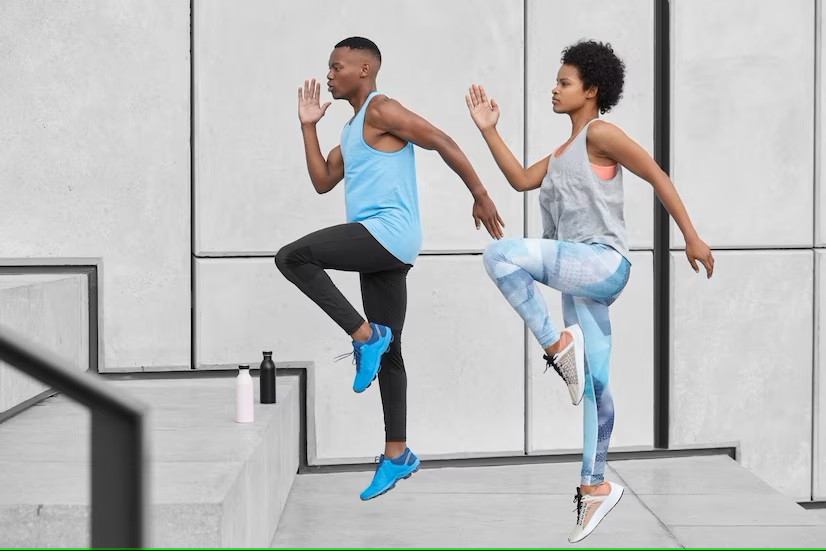Latihan HIIT dikatakan menjadi olahraga yang lebih efektif bagi orang yang ingin menurunkan berat badan dengan cepat. Latihan HIIT juga sangat cocok dilakukan orang yang tidak mempunyai banyak waktu untuk berolahraga rutin.
Sayangnya tidak semua orang cocok melakukan latihan HIIT. Siapa saja yang sebaiknya tidak menjalani latihan HIIT?
Apa itu Latihan HIIT?
Latihan HIIT adalah singkatan dari High Intensity Interval Training. Seperti istilahnya, HIIT menjadi bentuk latihan yang terdiri dari latihan intens singkat disertai dengan istirahat dan latihan intensitas rendah.
Periode latihan intensif ini bervariasi, mulai dari kurang dari 45 detik hingga beberapa menit. Latihan diselingi dengan istirahat dan olahraga ringan untuk jangka waktu yang sama, kemudian urutannya diulangi.
Berbeda dengan latihan yang bisa memakan 30-60 menit, HIIT membutuhkan waktu latihan lebih singkat. Dalam satu kali latihan, waktu total latihan HIIT mungkin sekitar 15-20 menit saja. Meskipun durasinya sangat singkat, manfaatnya cukup banyak.
HITT menjadi pilihan latihan praktis bagi orang yang memiliki kesibukan padat dan sulit berkomitmen pada sesi latihan yang lama.
Baca Juga: Ide Olahraga yang Bisa Dilakukan Bersama Pasangan
Orang dengan Kondisi Ini Sebaiknya tidak Melakukan HIIT
Walaupun HIIT memberikan ragam manfaat, tidak semua orang cocok melakukan HIIT. Berikut adalah beberapa kondisi di mana sebaiknya Anda tidak mencoba HIIT:
Memiliki problem jantung
HIIT adalah olahraga yang cocok dilakukan mereka yang muda dan sehat. Jika usia Anda lebih tua atau memiliki problem jantung, maka tidak aman untuk latihan HIIT.
Dengan riwayat penyakit jantung Anda perlu mendapatkan pemantauan ketat saat mencoba latihan HIIT. Anda juga mungkin perlu melakukan uji stres untuk memastikan tidak memiliki gejala seperti nyeri dada yang membuat HIIT justru menjadi latihan yang berbahaya.
Tidak pernah berolahraga sebelumnya
Orang yang tidak pernah berolahraga sebaiknya menghindari latihan HIIT. Jika Anda tiba-tiba terlibat pada latihan dengan intensitas tinggi tanpa memiliki pola olahraga rutin, maka risiko cedera dan otot tertarik akan meningkat. Kondisi ini sama seperti seseorang yang berolahraga tanpa melakukan pemanasan. Mereka cenderung akan lebih mudah cedera.
Sedang mengalami cedera atau baru saja sembuh dari cedera
Orang dengan cedera otot, persendian, tendon atau ligamen atau baru sembuh dari cedera tersebut sebaiknya tidak melakukan latihan HIIT. Olahraga boleh dilakukan kembali apabila benar-benar sembuh dari cedera agar tidak memperparah cedera atau menyebabkan cedera ulang.
Orang dengan cedera lutut misalnya, disarankan untuk berolahraga seperti berenang, berlatih bagian atas tubuh, berjalan di atas treadmill, atau memperkuat tubuh bagian atas dengan mesin rowing (dayung).
Baca Juga: Manfaat Penggunaan Knee Sleeves Pada Cedera Lutut
Sedang hamil
Ibu hamil dengan kondisi kesehatan yang baik membutuhkan olahraga ringan seperti jalan kaki 30 menit, lima kali dalam seminggu. Berjalan menjadi latihan yang baik selama kehamilan karena memberikan tekanan minimal pada persendian. Anda juga bisa mencoba berenang atau bersepeda statis selama mempertahankan beban yang relatif rendah.
Baru saja melahirkan
Ibu yang baru saja melahirkan per vaginam bisa mulai berolahraga kapan saja setelah melahirkan dengan catatan tidak memiliki keluhan atau kondisi kesehatan tertentu. Sedangkan ibu yang melahirkan secara sesar harus menunggu setidaknya 3-6 bulan untuk kembali berolahraga.
Olahraga yang cocok dilakukan setelah melahirkan adalah olahraga dengan intensitas rendah atau sedang. Anda bisa membagi waktu berolahraga 150 menit dalam seminggu, artinya 30 menit setiap hari lima kali dalam seminggu atau membaginya dalam porsi lebih kecil selama tujuh hari.
Olahraga setelah melahirkan membantu meningkatkan kualitas tidur, mengatasi stres, membantu menurunkan berat badan ekstra, memperkuat tubuh dan otot perut, meningkatkan energi. Namun, berapa lama, kapan olahraga dimulai, jenis olahraga apa yang aman untuk Anda sebaiknya didiskusikan kembali dengan dokter. Hindari olahraga dengan intensitas tinggi seperti HIIT sampai tubuh Anda benar-benar pulih.
Mau tahu tips dan trik kesehatan, pertolongan pertama, dan home remedies lainnya? Cek di sini, ya!
- dr. Monica Salim
Beth Sissons (2020). What are the benefits of high intensity interval training (HIIT)?. Available from: https://www.medicalnewstoday.com/articles/327474
Grant Tinslet, PhD, CSCS,CISSN and Tayler Read, BSc, CPT (2021).
7 Benefits of High Intensity Interval Training (HIIT). Available from: https://www.healthline.com/nutrition/benefits-of-hiit
Julie Corliss (2021). High-intensity exercise and your heart. Available from: https://www.health.harvard.edu/exercise-and-fitness/high-intensity-exercise-and-your-heart
Medline Plus (2020). How to avoid exercise injuries. Available from: https://medlineplus.gov/ency/patientinstructions/000859.htm
Paige Waehner, CPT (2020). Best Cardio Workouts and Exercises for Bad Knees. Available from: https://www.verywellfit.com/best-cardio-workouts-and-exercises-for-bad-knees-4138372
Mayo Clinic (2021). Pregnancy and exercise: Baby, let's move!. Available from: https://www.mayoclinic.org/healthy-lifestyle/pregnancy-week-by-week/in-depth/pregnancy-and-exercise/art-20046896
Mayo Clinic (2021). Exercise after pregnancy: How to get started. Available from: https://www.mayoclinic.org/healthy-lifestyle/labor-and-delivery/in-depth/exercise-after-pregnancy/art-20044596
The American College of Obstetricians and Gynecologist (2022). Exercise After Pregnancy. Available from: https://www.acog.org/womens-health/faqs/exercise-after-pregnancy











